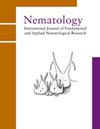Comparison of transmission of the pine wood nematode, Bursaphelenchus xylophilus, via two different pathways from Monochamus alternatus to host trees
IF 1.2
4区 生物学
Q2 ZOOLOGY
引用次数: 0
Abstract
Bursaphelenchus xylophilus causes pine wilt disease and is transmitted to host trees by cerambycid adults of the genus Monochamus. There are two primary transmission pathways: via vector feeding wounds to healthy trees and via the oviposition wounds to dying or recently dead trees. To determine the ratio of nematodes transmitted via the different pathways, M. alternatus female adults were reared on Pinus densiflora fresh twig sections and wood pieces with the bark made favourable for oviposition. Transmission curves of B. xylophilus to twig sections were similar in shape to the nematode departure curves for each vector, whereas the transmission curves to wood pieces were dissimilar to the departure curves because of different age classes at the peak between the curves. Consequently, there was no similarity in shape between two transmission curves to twig sections and wood pieces. Of B. xylophilus transmitted to twig sections and wood pieces after vectors constructed the first oviposition wound, 38.7% was transmitted to twig sections and 61.3% to wood pieces. Using the results of present and previous studies, GLM analysis indicated that the probability of B. xylophilus transmission to twig sections was 0.481 and that B. xylophilus had a 9.7 times higher likelihood of feeding-related transmission to oviposition-related transmission than non-pathogenic B. mucronatus. Thus, the reproductively mature vectors are considered to be related to the incidence of pine wilt disease and dispersal studies on mature vectors would help to predict the expansion rate of areas affected by the disease in the current year.松材线虫松材线虫通过两种不同途径从松毛虫传播到寄主树木的比较
松材线虫引起松材枯萎病,并由Monochamus属的神经酰胺成虫传播给寄主树木。有两种主要的传播途径:通过媒介给健康树木喂食伤口,以及通过产卵伤口给垂死或最近死亡的树木。为了确定线虫通过不同途径传播的比例,在赤松新鲜枝条段和树皮有利于产卵的木片上饲养交流松雌成虫。对于每种载体,松材线虫到枝条部分的传播曲线在形状上与线虫离开曲线相似,而到木材的传播曲线与离开曲线不同,因为曲线之间峰值的年龄级不同。因此,树枝截面和木材的两条传输曲线在形状上并不相似。在媒介构建第一个产卵伤口后,传播到枝条段和木片的木杆菌中,38.7%传播到枝条节,61.3%传播到木片。利用目前和以前的研究结果,GLM分析表明,巴豆传播到枝条部分的概率为0.481,巴豆与非致病性短尖巴豆相比,由进食相关传播到产卵相关传播的可能性高9.7倍。因此,繁殖成熟的病媒被认为与松枯萎病的发病率有关,对成熟病媒的扩散研究将有助于预测当年受该病影响地区的扩大率。
本文章由计算机程序翻译,如有差异,请以英文原文为准。
求助全文
约1分钟内获得全文
求助全文
来源期刊

Nematology
生物-动物学
CiteScore
2.60
自引率
33.30%
发文量
67
审稿时长
3 months
期刊介绍:
Nematology is an international journal for the publication of all aspects of nematological research (with the exception of vertebrate parasitology), from molecular biology to field studies. Papers on nematode parasites of arthropods, and on soil free-living nematodes, and on interactions of these and other organisms, are particularly welcome. Research on fresh water and marine nematodes is also considered when the observations are of more general interest.
Nematology publishes full research papers, short communications, Forum articles (which permit an author to express a view on current or fundamental subjects), perspectives on nematology, and reviews of books and other media.
 求助内容:
求助内容: 应助结果提醒方式:
应助结果提醒方式:


